大学英语四级语法精要:情态动词(四)
- 格式:docx
- 大小:17.64 KB
- 文档页数:2
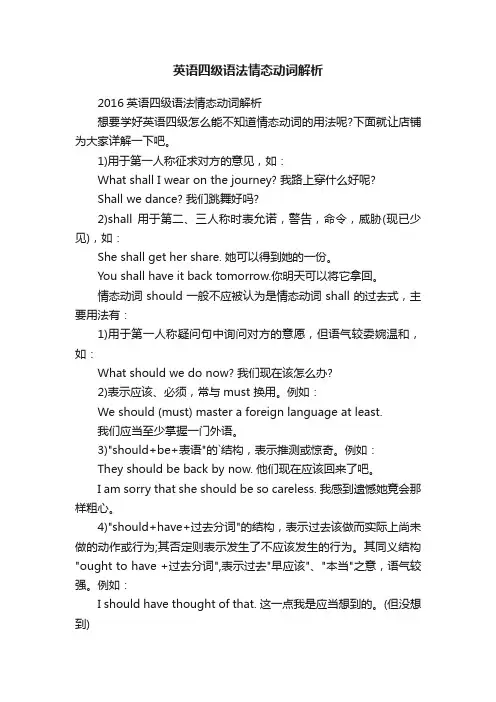
英语四级语法情态动词解析2016英语四级语法情态动词解析想要学好英语四级怎么能不知道情态动词的用法呢?下面就让店铺为大家详解一下吧。
1)用于第一人称征求对方的意见,如:What shall I wear on the journey? 我路上穿什么好呢?Shall we dance? 我们跳舞好吗?2)shall 用于第二、三人称时表允诺,警告,命令,威胁(现已少见),如:She shall get her share. 她可以得到她的一份。
You shall have it back tomorrow.你明天可以将它拿回。
情态动词should一般不应被认为是情态动词shall的过去式,主要用法有:1)用于第一人称疑问句中询问对方的意愿,但语气较委婉温和,如:What should we do now? 我们现在该怎么办?2)表示应该、必须,常与must 换用。
例如:We should (must) master a foreign language at least.我们应当至少掌握一门外语。
3)"should+be+表语"的`结构,表示推测或惊奇。
例如:They should be back by now. 他们现在应该回来了吧。
I am sorry that she should be so careless. 我感到遗憾她竟会那样粗心。
4)"should+have+过去分词"的结构,表示过去该做而实际上尚未做的动作或行为;其否定则表示发生了不应该发生的行为。
其同义结构"ought to have +过去分词",表示过去"早应该"、"本当"之意,语气较强。
例如:I should have thought of that. 这一点我是应当想到的。
(但没想到)They should not have left so soon.他们不应当走得这么早。
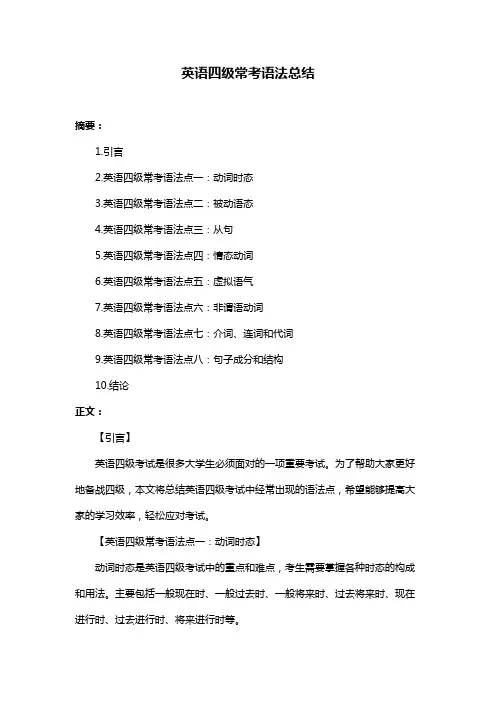
英语四级常考语法总结摘要:1.引言2.英语四级常考语法点一:动词时态3.英语四级常考语法点二:被动语态4.英语四级常考语法点三:从句5.英语四级常考语法点四:情态动词6.英语四级常考语法点五:虚拟语气7.英语四级常考语法点六:非谓语动词8.英语四级常考语法点七:介词、连词和代词9.英语四级常考语法点八:句子成分和结构10.结论正文:【引言】英语四级考试是很多大学生必须面对的一项重要考试。
为了帮助大家更好地备战四级,本文将总结英语四级考试中经常出现的语法点,希望能够提高大家的学习效率,轻松应对考试。
【英语四级常考语法点一:动词时态】动词时态是英语四级考试中的重点和难点,考生需要掌握各种时态的构成和用法。
主要包括一般现在时、一般过去时、一般将来时、过去将来时、现在进行时、过去进行时、将来进行时等。
【英语四级常考语法点二:被动语态】被动语态在英语四级考试中也非常重要,主要有三种形式:一般被动语态、完成被动语态和被动语态的否定形式。
掌握被动语态的用法,有助于提高阅读理解和写作的能力。
【英语四级常考语法点三:从句】从句是英语四级考试中不可或缺的部分,主要包括主语从句、宾语从句、表语从句、定语从句和状语从句。
学会识别和运用各种从句,对提高四级成绩至关重要。
【英语四级常考语法点四:情态动词】情态动词在英语四级考试中占有重要地位,如:can、could、may、might、must、should等。
掌握情态动词的用法,有助于提高语法填空和完形填空的正确率。
【英语四级常考语法点五:虚拟语气】虚拟语气在英语四级考试中也有一定的出现频率,主要包括条件句中的虚拟语气、宾语从句中的虚拟语气、主语从句中的虚拟语气等。
学会运用虚拟语气,能让你的句子更加丰富多彩。
【英语四级常考语法点六:非谓语动词】非谓语动词包括动词不定式、动名词和分词。
在英语四级考试中,非谓语动词的应用范围广泛,如:作主语、作宾语、作定语等。
【英语四级常考语法点七:介词、连词和代词】介词、连词和代词在英语四级考试中贯穿始终,掌握它们的使用方法,能有效提高填空题和选择题的正确率。
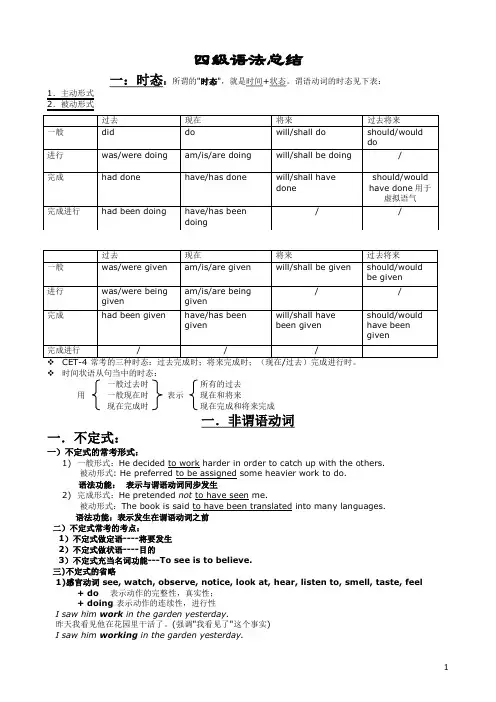
四级语法总结一:时态:所谓的"时态",就是时间+状态。
谓语动词的时态见下表:1.主动形式2.被动形式❖时间状语从句当中的时态:一般过去时所有的过去用一般现在时表示现在和将来现在完成时现在完成和将来完成一.非谓语动词一.不定式:一)不定式的常考形式:1)一般形式:He decided to work harder in order to catch up with the others.被动形式: He preferred to be assigned some heavier work to do.语法功能:表示与谓语动词同步发生2)完成形式:He pretended not to have seen me.被动形式:The book is said to have been translated into many languages.语法功能:表示发生在谓语动词之前二)不定式常考的考点:1)不定式做定语----将要发生2)不定式做状语----目的3)不定式充当名词功能---To see is to believe.三)不定式的省略1)感官动词 see, watch, observe, notice, look at, hear, listen to, smell, taste, feel+ do表示动作的完整性,真实性;+ doing表示动作的连续性,进行性I saw him work in the garden yesterday.昨天我看见他在花园里干活了。
(强调"我看见了"这个事实)I saw him working in the garden yesterday.昨天我见他正在花园里干活。
(强调"我见他正干活"这个动作)❖感官动词后面接形容词而不是副词:The cake tastes good; It feels comfortable.2) 使役动词 have bid make let 等词后不定式要省略但同1)一样被动以后要还原toI ‘d like to have John do it.I have my package weighed.Paul doesn’t have to be made to learn.3) help help sb do help sb to do help do help to do四)有些动词后只跟不定式如:want,wish,hope,manage,promise,refuse,pretend,plan, offer,decide,agree,expect allow sb to do, cause sb to do , permit sb to do, enable sb to doforce sb to do. be more likely to do love to do warn sb to do be able to dobe ambitious to do. begin to do . start to do五) 有的时候to后面要接-ing形式accustom (oneself) to; be accustomed to; face up to; in addition to; look forward to; object to; be reduced to; resign oneself to; be resigned to; resort to; sink to; be used to; be alternative to; be close/closeness to; be dedication/dedicated to; be opposition/opposed to; besimilarity/similar to.三、need/want 后的-ing形式具有被动的意思。
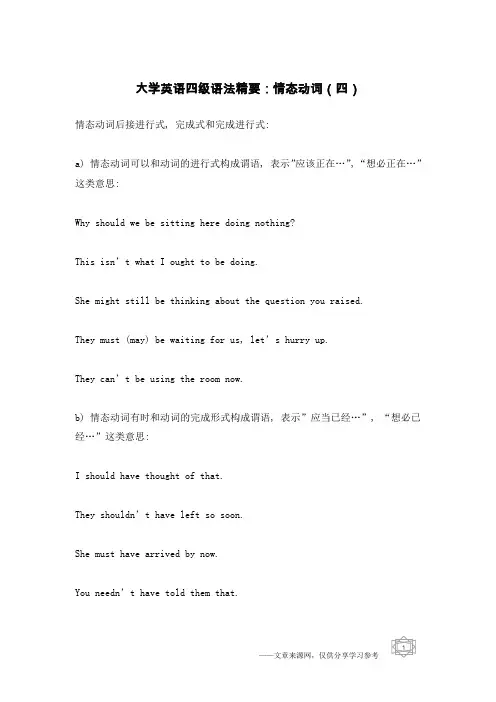
大学英语四级语法精要:情态动词(四)情态动词后接进行式, 完成式和完成进行式:a) 情态动词可以和动词的进行式构成谓语, 表示”应该正在…”, “想必正在…”这类意思:Why should we be sitting here doing nothing?This isn’t what I ought to be doing.She might still be thinking about the question you raised.They must (may) be waiting for us, let’s hurry up.They can’t be using the room now.b) 情态动词有时和动词的完成形式构成谓语, 表示”应当已经…”, “想必已经…”这类意思:I should have thought of that.They shouldn’t have left so soon.She must have arrived by now.You needn’t have told them that.Where can (could) he have gone?He can’t have finished the work so soon.He may not have achieved all his aims. But his effort is praise-worthy.We ought to have give you more help.c) 情态动词间或也可以和一个动词的完成进行式构成谓语,表示”应当一直在…”, “想必一直在…”这类意思:They are sweating all over. They must have been working in the fields.They may have been discussing the problem this morning.You should have been waiting for us. Why haven’t you?She couldn’t have been swimming all day.。
![[译林版]4A Unit4 语法归纳](https://uimg.taocdn.com/f143761d9b6648d7c0c74609.webp)
Unit 4 I can play basketball语法情态动词can的基本用法情态动词can有一定的词义,但不能独立存在,它必须与动词原形一起构成谓语。
情态动词can没有人称和数的变化。
其具体用法如下:1.表示"能、会",指脑力或体力方面的"能力"。
例如: I can speak English.我会讲英语。
Jim can swim but I can't.吉姆会游泳,但我不会。
2.表示"可能",常用于否定句或疑问句中,指某种可能性。
例如: Han Mei can't be in the classroom.韩梅不可能在教室里。
Can he come here today, please?请问他今天能到这里来吗?3.表示"可以",常用于口语中,指许可或请求做某事。
例如: Can I have a cup of tea, please?请问我可以喝一杯茶吗?You can go out.你可以出去了?补充:①can在口语中可以代替may,表示许可或可以。
②can't在口语中代替mustn't时,表示禁止或不准。
例如:You can't play football in the street.不准在马路上踢足球。
1.肯定句型为:主语+can+动词原形+其它。
例如: They can play basketball.他们能打篮球。
She can dance.她会跳舞。
You can go to watch TV.你可以去看电视了。
2.否定句型为:主语+can not(can't/cannot)+动词原形+其它。
表示"某人不能(不会。
不可能)做……"。
其中can't是can not的缩略式,英国多写成cannot。
例如: You cannot pass the ball like this.你不能像这样传球。
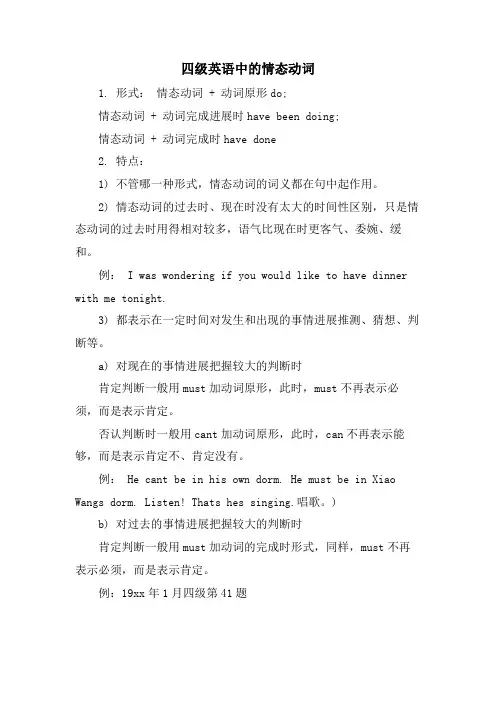
四级英语中的情态动词
1. 形式:情态动词 + 动词原形do;
情态动词 + 动词完成进展时have been doing;
情态动词 + 动词完成时have done
2. 特点:
1) 不管哪一种形式,情态动词的词义都在句中起作用。
2) 情态动词的过去时、现在时没有太大的时间性区别,只是情态动词的过去时用得相对较多,语气比现在时更客气、委婉、缓和。
例: I was wondering if you would like to have dinner with me tonight.
3) 都表示在一定时间对发生和出现的事情进展推测、猜想、判断等。
a) 对现在的事情进展把握较大的判断时
肯定判断一般用must加动词原形,此时,must不再表示必须,而是表示肯定。
否认判断时一般用cant加动词原形,此时,can不再表示能够,而是表示肯定不、肯定没有。
例: He cant be in his own dorm. He must be in Xiao Wangs dorm. Listen! Thats hes singing.唱歌。
)
b) 对过去的事情进展把握较大的判断时
肯定判断一般用must加动词的完成时形式,同样,must不再表示必须,而是表示肯定。
例:19xx年1月四级第41题
Marys score on the test is the highest in her class; she have studied very hard.。

情态动词全部知识点总结一、情态动词的基本概念及用法1. 情态动词的定义和特点情态动词是一种特殊的助动词,用来表示说话人对某种情态或可能性的态度。
情态动词具有一定的情态意义,表示说话人的态度、愿望、命令、建议、可能性等。
2. 情态动词的基本特点(1)情态动词没有人称和数的变化,即其形式不受主语的变化而变化;(2)情态动词后面通常接动词原形,构成情态动词的基本结构;(3)情态动词后面一般不加不定式的to,除了ought to外,其他情态动词后面不接to形式的动词。
二、情态动词的用法1. 表示能力、许可和请求(1)can和coulda. 表示能力,用于表达某人有能力做某事;例如:She can speak Chinese.(她会说中文。
)b. 表示请求,用于表示请求或允许;例如:Can I borrow your pen?(我能借你的笔吗?)(2)may和mighta. 表示许可,用于请求许可或征求对方的意见;例如:May I come in?(我可以进来吗?)b. 表示可能性,用于表示可能的情况;例如:It may rain tomorrow.(明天可能会下雨。
)2. 表示建议、命令和义务(1)shoulda. 表示建议,用于给出建议或提出主张;例如:You should see a doctor.(你应该去看医生。
)b. 表示义务,用于表示责任或义务;例如:We should obey the law.(我们应该遵守法律。
)(2)ought toa. 表示责任或义务,用于表示应该做的事情;例如:You ought to apologize to her.(你应该向她道歉。
)3. 表示可能性和必然性(1)musta. 表示必然性,用于表示肯定的推断或必然的结论;例如:He must be at home now.(他现在一定在家。
)b. 表示义务,用于表示应遵守的规定或责任;例如:Students must wear school uniforms.(学生必须穿校服。
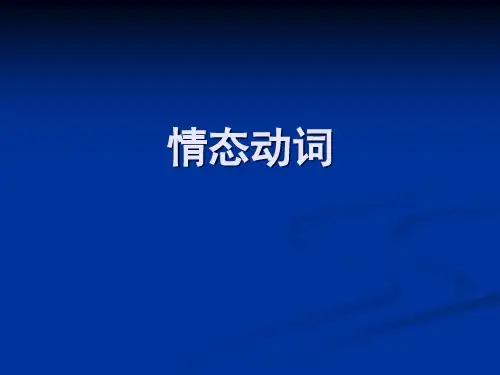
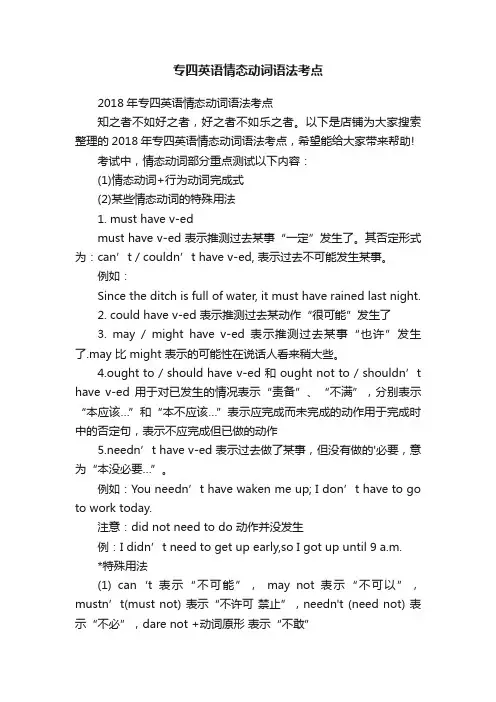
专四英语情态动词语法考点2018年专四英语情态动词语法考点知之者不如好之者,好之者不如乐之者。
以下是店铺为大家搜索整理的2018年专四英语情态动词语法考点,希望能给大家带来帮助!考试中,情态动词部分重点测试以下内容:(1)情态动词+行为动词完成式(2)某些情态动词的特殊用法1. must have v-edmust have v-ed 表示推测过去某事“一定”发生了。
其否定形式为:can’t / couldn’t have v-ed, 表示过去不可能发生某事。
例如:Since the ditch is full of water, it must have rained last night.2. could have v-ed 表示推测过去某动作“很可能”发生了3. may / might have v-ed 表示推测过去某事“也许”发生了.may 比 might 表示的可能性在说话人看来稍大些。
4.ought to / should have v-ed 和ought not to / shouldn’t have v-ed 用于对已发生的情况表示“责备”、“不满”,分别表示“本应该…”和“本不应该…”表示应完成而未完成的动作用于完成时中的否定句,表示不应完成但已做的动作5.needn’t have v-ed 表示过去做了某事,但没有做的'必要,意为“本没必要…”。
例如:You needn’t have waken me up; I don’t have to go to work today.注意:did not need to do 动作并没发生例:I didn’t need to get up early,so I got up until 9 a.m.*特殊用法(1) can‘t表示“不可能”,may not 表示“不可以”,mustn’t(must not) 表示“不许可禁止”,needn't (need not) 表示“不必”,dare not +动词原形表示“不敢”(2) must表推测的否定现在式用can’t ,过去式用couldn’t(3)May I / we …?这一类疑问句的肯定回答为Yes, please.或Certainly;否定回答为Please don’t.或No, you mustn’t. 例如:“May we leave now?” “No, you mustn’t. You haven’t finished your home work yet.”(4) need I / we …?这一类疑问句的肯定回答为Yes, we must; 否定回答为needn’t(5)在回答must引起的问题时,如果是否定的答复,不能用mustn’t,而要用needn’t或don’t have to(6)May/might as well may……but….(表转折)(7) I wish to go home with you, may I?(8) Do help yourself to have fruit, won’t you/ will you? (表示一种委婉的请求)*情态动词短语的使用would like to do…would rather do…would rather + 从句would prefer to do...had better do...*情态动词: will(愿意), shall(将), must(必须), can, may, would, should(应该), might, could, ought to, used to(过去常常), need(需要), dare(竟敢),have to(不得不)*dare, need 也可作一般(行为)动词*情态动词一般用法的否定:mustn’t 不准, 禁止,不要can’t(couldn’t) 不会;不能;may (might) not 不可以;needn’t 没必要( = don’t have to )used not/usedn’t to或didn’t use to… 过去不…dare not 不敢*情态动词推测用法Must 一定,肯定can’t (couldn’t) 不可能Can/ could 可能Can’t (couldn’t) 不可能may/ might “可能,也许” May (might) not 也许不,可能不*推断用法should/ought to“按理应当,应该是; shouldn’t 不应该( = ought not to )*情态动词+have +done结构表示对过去动作的推测1. must have done:对过去的肯定推测,译作“一定做了…”,只能用于肯定句中。
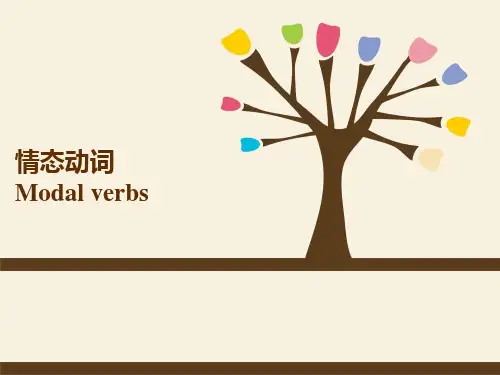
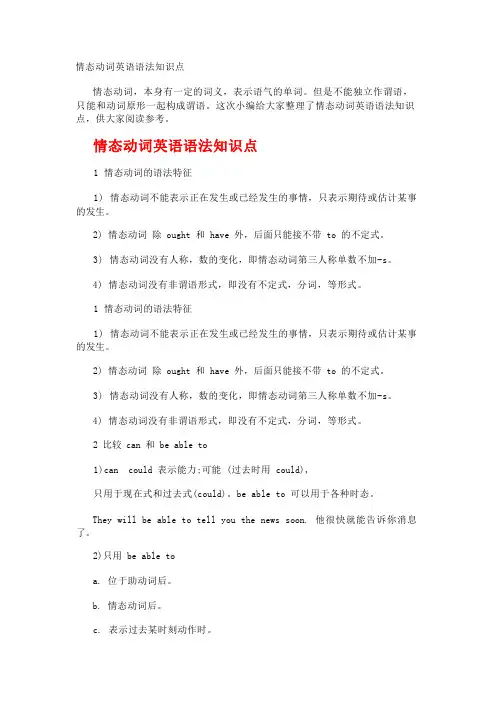
情态动词英语语法知识点情态动词,本身有一定的词义,表示语气的单词。
但是不能独立作谓语,只能和动词原形一起构成谓语。
这次小编给大家整理了情态动词英语语法知识点,供大家阅读参考。
1 情态动词的语法特征1) 情态动词不能表示正在发生或已经发生的事情,只表示期待或估计某事的发生。
2) 情态动词除 ought 和 have 外,后面只能接不带 to 的不定式。
3) 情态动词没有人称,数的变化,即情态动词第三人称单数不加-s。
4) 情态动词没有非谓语形式,即没有不定式,分词,等形式。
1 情态动词的语法特征1) 情态动词不能表示正在发生或已经发生的事情,只表示期待或估计某事的发生。
2) 情态动词除 ought 和 have 外,后面只能接不带 to 的不定式。
3) 情态动词没有人称,数的变化,即情态动词第三人称单数不加-s。
4) 情态动词没有非谓语形式,即没有不定式,分词,等形式。
2 比较 can 和 be able to1)can could 表示能力;可能 (过去时用 could),只用于现在式和过去式(could)。
be able to 可以用于各种时态。
They will be able to tell you the news soon. 他很快就能告诉你消息了。
2)只用 be able toa. 位于助动词后。
b. 情态动词后。
c. 表示过去某时刻动作时。
d. 用于句首表示条件。
e. 表示成功地做了某事时,只能用 was/were able to,不能用 could。
He was able to flee Europe before the war broke out. = He managed to flee Europe before the war broke out.注意:could 不表示时态1)提出委婉的请求, (注意在回答中不可用 could)。
--- Could I have the television on?--- Yes, you can. / No, you can't.2)在否定,疑问句中表示推测或怀疑。
(完整版)情态动词归纳大学专四语法情态动词有can (could), may (might), must, have to, shall (should, will (would), dare (dared), need (needed), ought to等。
情态动词无人称和数的变化;不能单独使用,必须与其后的动词原形构成谓语。
一、can, could1) 表示能力(体力、知识、技能)。
Can you lift this heavy box?(体力)Mary can speak three languages.(知识)Can you skate?(技能)此时可用be able to代替。
Can只有一般现在时和一般过去式;而be able to则有更多的时态。
I’ll not be able to come this afternoon.2) 表示请求和允许。
-----Can I go now?----- Yes, you can. / No, you can’t.此时可与may互换。
在疑问句中还可用could,might代替,不是过去式,只是语气更委婉,不能用于肯定句和答语中。
----Could I come to see you tomorrow?---- Yes, you can. ( No, I’m afraid not. )3) 表示客观可能性(客观原因形成的能力)。
They’ve changed the timetable, so we can go by bus instead.This hall can hold 500 people at least.4) 表示推测(惊讶、怀疑、不相信的态度),用于疑问句、否定句和感叹句中。
Can this be true?This can’t be done by him.How can this be true?二、may, might1) 表示请求和允许。
情态动词英语语法知识精讲情态动词(modal verb)本身有词义,表示说话人的语气或情态,但词义不完全,不能单独用作谓语动词,一般只能和动词原形一起构成谓语动词。
小编在这里整理了相关资料,希望能帮助到您。
特征1)情态动词(modal verb)本身有词义,表示说话人的语气或情态,但词义不完全,不能单独用作谓语动词,一般只能和动词原形一起构成谓语动词。
2)情态动词所表示的情态有:命令、允诺、请求、拒绝、愿望、愿意、义务、必要、可能、能力、敢于、需要等。
3)情态动词(ought 除外)和助动词 shall,will,should,would 一样,后面的动词不定式一般皆不带。
形式变化1)没有人称和数的变化,第三人称单数的现在时也无变化。
如:I can We canYou can You canHeThey canShe canIt2)有些情态动词有过去式,有少数过去式和它的原形相同。
a)有过去式的情态动词有:may -- wouldcan ―― couldmay ― ― nigh tshall -- shouldhave to -- had tob)过去式不变的情态动词有:must - must (或 had to)ought to - ought toneed---needdare - dare(亦可用 dared)3)大多数情态动词后面可用动词的进行式、完成式和被动形式,如:can(may,must)be doing,can(may,must) have done,can(may,must)be done 等。
否定式情态动词和助动词一样,后面可直接跟否定词not。
现将情态动词的否定式及其否定式的简略式(简略式用于口语中)列举如下:shall not--shan't [FB:nt]will not---won't [wEunt]can not-can't [kB:nt]must not-mustn't [5mQsnt]should not-- shouldn'twould not-- wouldn'tcould not-- couldn'tdare not- daren't [dZEnt]need not-- needn't在疑问句中的用法情态动词在疑问句中的用法和助动词相同。
情态动词知识点总结情态动词是英语中的一类特殊动词,用于表达说话人的态度、观点或情感。
情态动词具有一些独特的语法和用法规则,掌握了这些规则,我们就能更准确地表达自己的意思。
本文将对情态动词的知识点进行总结,以帮助读者加深对该语法现象的理解。
一、情态动词的定义和特点情态动词(modal verbs)是英语中的一类特殊动词,用于表示说话人的意愿、可能性、许可、推测、建议、命令等情态。
情态动词有一些独特的特点:1. 情态动词没有人称和数的变化。
即不论主语是什么,情态动词的形式都保持不变。
2. 情态动词后面接动词原形(除了 ought to 外)。
3. 情态动词本身没有时态和语态的变化,通过与其他动词的搭配来表达时态和语态。
4. 情态动词不能单独用作谓语,必须与其他动词搭配使用。
二、常见的情态动词及其用法下面是常见的情态动词及其用法的详细介绍:1. can表示能力、许可或可能性。
例如:- I can swim.(我会游泳。
)- Can I borrow your pen?(我能借用你的笔吗?)- It can be difficult to learn a new language.(学习一门新语言可能会很困难。
)2. could表示过去或虚拟的能力、许可或可能性。
例如:- When I was young, I could run very fast.(当我年轻的时候,我跑得很快。
)- If I had more time, I could study abroad.(如果我有更多时间,我可以出国留学。
)- Could you help me with this problem?(你能帮我解决这个问题吗?)3. may表示可能性、许可或问询。
例如:- It may rain tomorrow.(明天可能会下雨。
)- May I use your phone?(我可以用一下你的手机吗?)- May I ask you a question?(我可以问你一个问题吗?)4. might表示可能性,用法与 may 相似。
大学情态动词知识点总结情态动词是英语中的一个重要部分,它们用于表示说话人对某种行为的态度或者能力。
在大学英语学习中,情态动词是一个重要的语法知识点,掌握好情态动词的用法能够帮助我们更准确地表达自己的意思,从而提高语言表达能力。
本文将围绕大学英语学习中常见的情态动词总结其知识点,包括情态动词的概念和用法、情态动词的时态和语态等方面,希望能够帮助同学们更好地掌握这一部分知识。
一、情态动词的概念和用法情态动词是一类辅助动词的一种,它们用于表示说话人对某种行为或状态的态度或者能力。
常见的情态动词包括can、could、may、might、must、shall、should、will、would等。
情态动词有以下几个特点:1. 情态动词没有第三人称单数的变化形式,即情态动词后面不加-s或-es。
2. 情态动词后面必须紧跟动词原形。
3. 情态动词没有现在分词或过去分词的形式。
4. 情态动词没有非谓语形式,即不带to的不定式。
情态动词的用法主要包括以下几个方面:1. 表示能力或可能性。
例如:I can speak English.(我会说英语。
) She may come tomorrow.(她可能明天会来。
)2. 表示务必或必须。
例如:You must finish the work on time.(你必须按时完成工作。
)3. 表示应当或建议。
例如:You should apologize to her.(你应该向她道歉。
)4. 表示将要或预测。
例如:It will rain tomorrow.(明天会下雨。
)二、情态动词的时态和语态情态动词的时态和语态变化相对简单,一般来说不受时态和语态的影响,而是通过助动词来表示时间和语态的变化。
下面对情态动词在不同时态和语态下的用法进行总结:1. 现在时态(1)肯定句:情态动词+动词原形例如:You can speak English.(你会说英语。
)(2)否定句:情态动词+not+动词原形例如:You can not speak English.(你不会说英语。
大学四级英语语法基础:will与would用法辨析
很多同学在大学英语四级考试中会存在一些误区,认为语法不那么重要,那你就错了,它会把很多的学习英语中遇到的问题都迎刃而解,以下是小编给大家整理的大学英语四级考试语法基础:will与would用法辨析,希望可以帮到大家
1) will作情态动词,表示意愿、习惯等。
would表示过去的习惯。
「例如」
it will be highly appreciated if you will send us your latest price list.
on sundays he would get up early and go fishing.
2) will/would you please do……,would you like to do……,would you mind doing……
都表示建议、询问、请求等。
「例如」
will you please pass me a cup of tea?
would you like me to give you a hand?
this box is too heavy, ____give me a hand? (cet-4 1998,1)
a) would you mind
b) would you please
c) will you like to
d) will you please to
四个结构中,would you mind接动名词;would you please接动词原形;
will you like to不是正确结构;will you please to也不是正确结构,因此答案为b.。
大学英语四级语法精要:情态动词(四)
情态动词后接进行式, 完成式和完成进行式:
a) 情态动词可以和动词的进行式构成谓语, 表示”应该正在…”, “想必正在…”这类意思:
Why should we be sitting here doing nothing?
This isn’t what I ought to be doing.
She might still be thinking about the question you raised.
They must (may) be waiting for us, let’s hurry up.
They can’t be using the room now.
b) 情态动词有时和动词的完成形式构成谓语, 表示”应当已经…”, “想必已经…”这类意思:
I should have thought of that.
They shouldn’t have left so soon.
She must have arrived by now.
You needn’t have told them that.
Where can (could) he have gone?
He can’t have finished the work so soon.
He may not have achieved all his aims. But his effort is praise-
worthy.
We ought to have give you more help.
c) 情态动词间或也可以和一个动词的完成进行式构成谓语,表示”应当一直在…”, “想必一直在…”这类意思:
They are sweating all over. They must have been working in the fields.
They may have been discussing the problem this morning.
You should have been waiting for us. Why haven’t you?
She couldn’t have been swimming all day.。